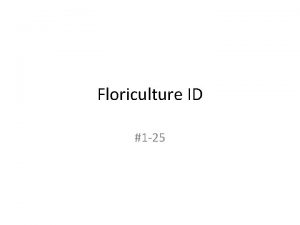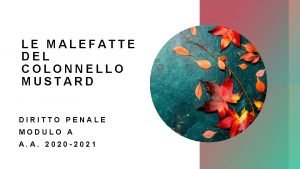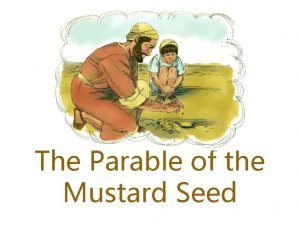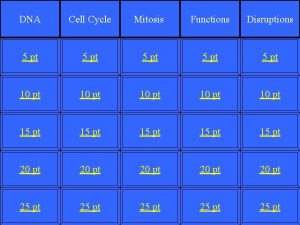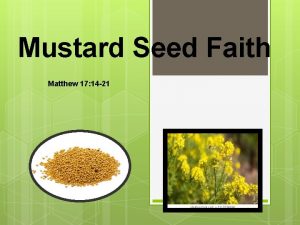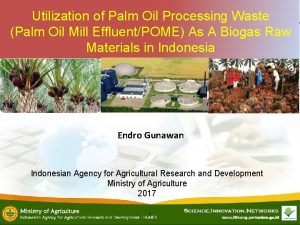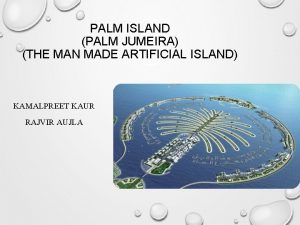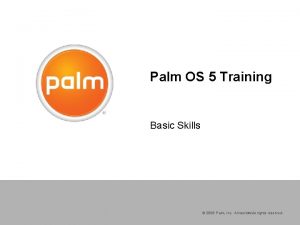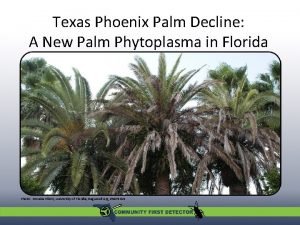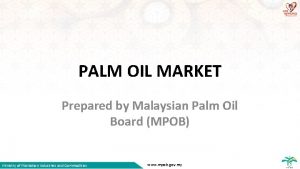Mustard Processing and Technology INTRODUCTION v After palm

























- Slides: 25

Mustard Processing and Technology

INTRODUCTION v After palm oil & soy bean -3 rd important oil seed crop in the world v (FAO data base) area of cultivation total seed production - 663697 ha - 468725 Mt/year v mustard growing countries Canada, Napal, USA, Russia, Myanmar Czech, Romania, Slovakia, Germany & France

v condiment manufacturing concentrated in Canada, USA, France, Germany, Japan & UK v Sri Lankan situation cultivated as subsidiary crop - seeds used as a condiment in cooking v growing area Badulla, Puttalam, Anuradhapura, Rathnapura, Nuwara Eliya & Matale

CLASSIFICATION OF MUSTARD Kingdom : Plantae : Angiosperm : Eudicots : Rosids Order : Brassicales Family : Brassicaceae Genus: Brassica Spices : B. nigra (black mustard) : B. juncea (brown or oriental mustard) : Sinapsis alba (yellow or white mustard)

v Mustard - seasonal crop - suit to short growing season - grown in drier regions for better seed quality - prefer well aerated soil with near neutral p. H

Commercial processing of mustard Mustard crop harvest Mild drying (32 o. C) Essential oil Pressed cake Fixed oil pressing Partial deoleating bran Commercial mustard seeds milling grinding Mustard flour Ground mustard Salt Spice vinegar Prepared mustard paste deheating grinding Deheated ground mustard

Ø Maturation - yellow mustard varieties mature in 80 -85 days - brown types require about 90 -95 days Ø Harvesting - common practice is to swathe crop: promote the drying process - brown mustards more susceptible for shattering: usually swathed - swathing should begin when 75 % of the seeds have reached their mature colour - in Europe this is done by mechanically: if crop has matured uniformly

Ø Drying - should dried soon after harvest to prevent the mould growth - initially carried out on the farm & completed at factory - recommended max. temp. for drying is 32 o. C: higher temp. may destroy enzyme called myrosinase - if MC <10% : increase the shelf life of seeds Under commercial farming Brown mustard: 1500 kg/ha Yellow mustard: 1000 kg/ha

Mustard seeds mustard seed, yellow Nutritional value per 100 g (3. 5 oz) Energy Carbohydrates - Sugars - Dietary fiber Fat -saturated -monounsaturated -polyunsaturated 470 kcal ( 1960 k. J) Yellow Mustard seeds 34. 94 g 6. 79 g 14. 7 g 28. 76 g 1. 46 g 19. 83 g 5. 39 g Protein 24. 94 g Water 6. 86 g Calcium 521 mg Potassium 682 mg Source: USDA nutrient database Black Mustard seeds

v Whole mustard seed has no flavours: but can produce “pungent taste” after chewing v Severity of pungent aroma varies with different mustards - B. M: highest pungency - Br. M: strong pungent aroma - Y. M : least pungent aroma v This flavour & pungency experienced due to enzymatic action in the presence of liquids: water, vinegar, grape juice. . etc

v Myrosinase exist in mustard tissues hydrolyses Glucosinolates (sinalbin & sinagrin) into Isothiocyanate: hot spiciness of prepared mustard is resulted v difference of pungent aroma between mustard type due to components responsible for the reaction and the end products produce v

Mustard flour Ø Milling - designed to separate the bran (testa & aleurone layer) from the flour (embryo & cotyledons) - size reduction done using different shaped rollers - flour is sifted to separate fine & coarse fraction Ox- powered mustard seed milling

v preservative & antioxident properties in addition to providing flavour and colour v used in sauce & salad dressing: emulsifying functions v oil isn’t removed from mustard seeds before milling Deheated ground mustard - produced ingredients with thickening, stabilizing & emulsifying properties - in this process, myrosinase is deactivated by controlled heat treatment & finally seeds are grounded & produced deheated ground mustard Mustard grinder

Mustard oil v 3 types of oil are produced from mustard seeds 1. mustard fixed oil 2. essential oil 3. oil made by infusing mustard seed extract into another vegetable oil: soybean oil Ø Mustard Fixed Oil - fixed oil extracted by the cold press method - extraction of the oil carried out by village rotary mills, expeller and hydraulic processes - crude oil is dark brown in colour & contains large proportion of FFA Oil expeller

Composition of mustard oil Monounsaturated Fatty Acids - erucic acid 42% - oleic acid 12% Polyunsaturated Fatty Acids - omega-3 -α-linolenic acid - omega-6 -linoleic acid Saturated Fatty Acids - 60% - 21% 6% 15% - 12% (http: //www. nal. usda. gov/fnic/cgi-bin/nut) Mustard oil - mustard oil is rich with EFAs: good for health -quality of mustard oil depend on: content of the fatty acids & their percentages

v mustard oil is one of the major edible oil in India - used in its crude state as a frying medium for several food preparations - also used, as a hair oil, illuminant and lubricant v In Sweden oil is used in the production of mayonnaise Ø Essential oil - essential oil is obtained from pressed cake: mixing with warm water to facilitate enzyme activity of “myrosinase” to release “isothiocyanate”( essential oil) - characteristic odour of mustard oil: sulphur containing essential oils

- essential oil of “black” & “brown” mustard is obtained by steam distillation of pressed cake - in contrast, essential oil of “yellow” mustard is obtained by solvent extraction: because “para-hydroxybenzyl isothiocyanate” is non- volatile Essential oil extraction plant Solvent extraction plant

Properties of “volatile oil (Allyl isothiocyanate)”extracted from brown & black mustard seeds § specific gravity § refractive index Brown mustard 0. 995 1. 5185 Black mustard 1. 015 -1. 025 1. 526 -1. 529 Ø The volatile oil is optically inactive Ø consist almost entirely of Allyl isothiocyanate (93%-99%) Ø mustard essential oil is harmful: because its high ‘Allyl isothiocyanate’ content. Fresh seeds or mustard powder do not possess essential oil: preparations made from these don’t contain ‘Allyl isothiocyanate’

Oleoresin v usually obtained from blend of the three different types of mustard to provide a balanced flavour v produced by extraction of mustard seeds with extraction solvents & further processed by solvent evaporation v consist with essential oil & Resin: yellow to light brown oily type liquid with a volatile oil content of 5 ml/100 g v 2 kg of oleoresin: equivalent to 45. 45 kg of the mustard Oleoresin extraction plant spice Ø Recommendation (http: //www. efsa. eu. int/science/nda_opinions/catindex_en. html) -mustard seed oil intake: 0. 57 mg/person/day -mustard seed oleoresin intake: 0. 009 mg/person/day

Quality specifications v According to federal classification condiment mustard is classified into 3 types: whole mustard seeds ground mustard flavours Ø whole mustard seed quality of mustard seeds is determined by the quantity of mature, undamaged seeds Yellow mustard seeds: small, globular, yellow in colour, clean looking hard seeds & shouldn't possess any volatile oil when crushed &mixed with water Brown mustard seeds: small, globular, brown colour hard seeds &when ground and mixed with water on 1 -2 basis must be liberated a sharp irritating odour & very pungent taste

- Seeds shouldn't contain more than 0. 7% of inert materials & 2% of damaged seeds - Black & brown mustard: minimum of 1. 0% & 0. 7% of ‘Allyl isothicyanate’ respectively -yellow or white mustard should yield 2. 3% of ‘ 4 -hydroxybenzyl isothiocyanate’ Ø Ground mustard - finished product should represent, seed ground in its whole form - without the outer hulls of husk removed & without removal of fixed oils - according to international standards mustard seed when ground must produce odour free of mustiness & rancidity

- uniformly ground to allow for a min. 5% by weight to pass through a US standard No. 15 sieve - should contain not more than 5% total ash – 1% acidic insoluble ash– 6% moisture Ø Flavour - is white yellow powder prepared from blend of powder derived from milling the endosperm of seed of whole mustard & ground mustard - should contain not more than 5% total ash – 5% acidic insoluble ash 10% moisture- 9% crude fibre & not less than 2. 5% non volatile ether esters ( source: Hand Book of Herbs & Spices by K. V Peter)

Other uses Ø Therapeutic uses - to treat skin diseases : high ‘sulphur’ content - stimulate the flow of salivary / gastric enzymes & promote appetite - In Ayurveda : mustard plasters are used to stimulate blood circulation & to treat worm infections Ø Industrial uses - Degradation products of ‘glucosinolates’ such as ‘isothiocyanates & ‘nitriles’ : bio-fumigants - mustard oil is incorporated to make leather soft / in soap making / as a lubricant & illumunant

Ø used as a green vegetable / salad crop Ø as green manure or as fodder crop Green manure As a salad crop

THANK YOU !
 Modified pen grasp
Modified pen grasp Adiantum spp. – maidenhair fern
Adiantum spp. – maidenhair fern Sabal palm assisted living palm coast
Sabal palm assisted living palm coast After me after me after me
After me after me after me If any man wants to come after me
If any man wants to come after me Mr and mrs mustard have six daughters answer
Mr and mrs mustard have six daughters answer Brassica classification
Brassica classification Disadvantages of palm vein technology
Disadvantages of palm vein technology Colonnello mustard
Colonnello mustard Asl ketchup
Asl ketchup Metaphor for waterfall
Metaphor for waterfall Mustard agent
Mustard agent Seed
Seed Mustard gas removes guanine from dna
Mustard gas removes guanine from dna Neighborhood processing in digital image processing
Neighborhood processing in digital image processing Secondary processing
Secondary processing What is interactive processing
What is interactive processing Bottom up and top down processing
Bottom up and top down processing Gloria suarez
Gloria suarez Bottom up and top down processing
Bottom up and top down processing Point processing in image processing example
Point processing in image processing example Histogram processing in digital image processing
Histogram processing in digital image processing Parallel processing vs concurrent processing
Parallel processing vs concurrent processing Laplacian filter
Laplacian filter Point processing in image processing
Point processing in image processing Morphological dilation
Morphological dilation

